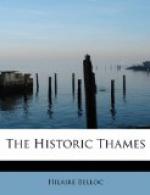The river, then, from Sandford downward has afforded upon either bank innumerable sites upon which a settlement could be formed. Above Sandford these sites are not to be found indifferently upon either bank, but now on one, now on the other. There is no case on the upper river of two villages facing each other on either side of the stream. But though the soil of this upper part was in general less suited to the establishment of settlements, a certain number of firmer stretches could be found, and advantage was taken of them to build.
There thus arose along the whole course of the Thames from its source to London a series of villages and towns, increasing in importance as the stream deepened and gave greater facilities to traffic, and bound together by the common life of the river. It was their highway, and it is as a highway that it must first be regarded.
Of the way in which the Thames was a necessary great road in early times, perhaps the best proof is the manner in which various parishes manage to get their water front at the expense of a somewhat unnatural shape to their boundaries. Thus Fawley in Buckinghamshire has a curious and interesting arrangement of this sort thrusting down from the hills a tongue of land which ends in a sort of wharfage on the river just opposite Remenham church. In Berkshire there are also several examples of this. On the upper river Dractmoor and Kingston Bagpuise are both very narrow and long, a shape forced upon them by the necessity of having this outlet upon the river in days when the life of a parish was a real one and the village was a true and self-sufficing unit. Next to them Fyfield does the same thing. Lower down, near Wallingford, the parish of Brightwell has added on a similar eccentric edge to the north and east so that it may share in the bank; but perhaps the best example of all in this connection is the curious extension below Reading. Here land which is of no use for human habitation—water meadows continually liable to floods—runs out from the parish northward for a good mile. These lands are separated from the river during the whole of this extension until at last a bend of the stream gives the parish the opportunity it has evidently sought in thus extending its boundaries. On the Oxford bank Standlake and Brighthampton do the same thing upon the Upper Thames and to some extent Eynsham; for when one thinks how far back Eynsham stands from the river it is somewhat remarkable that it should have claimed the right to get at the stream. Below Oxford there is another most interesting instance of the same thing in the case of Littlemore. Littlemore stands on high and dry land up above the river somewhat set back from it. Sandford evidently interfered with its access to the water, and Littlemore has therefore claimed an obviously artificial extension for all the world like a great foot added on to the bulk of the parish. This “foot” includes Kennington Island, and runs up the meadows to the foot of that eyot.




